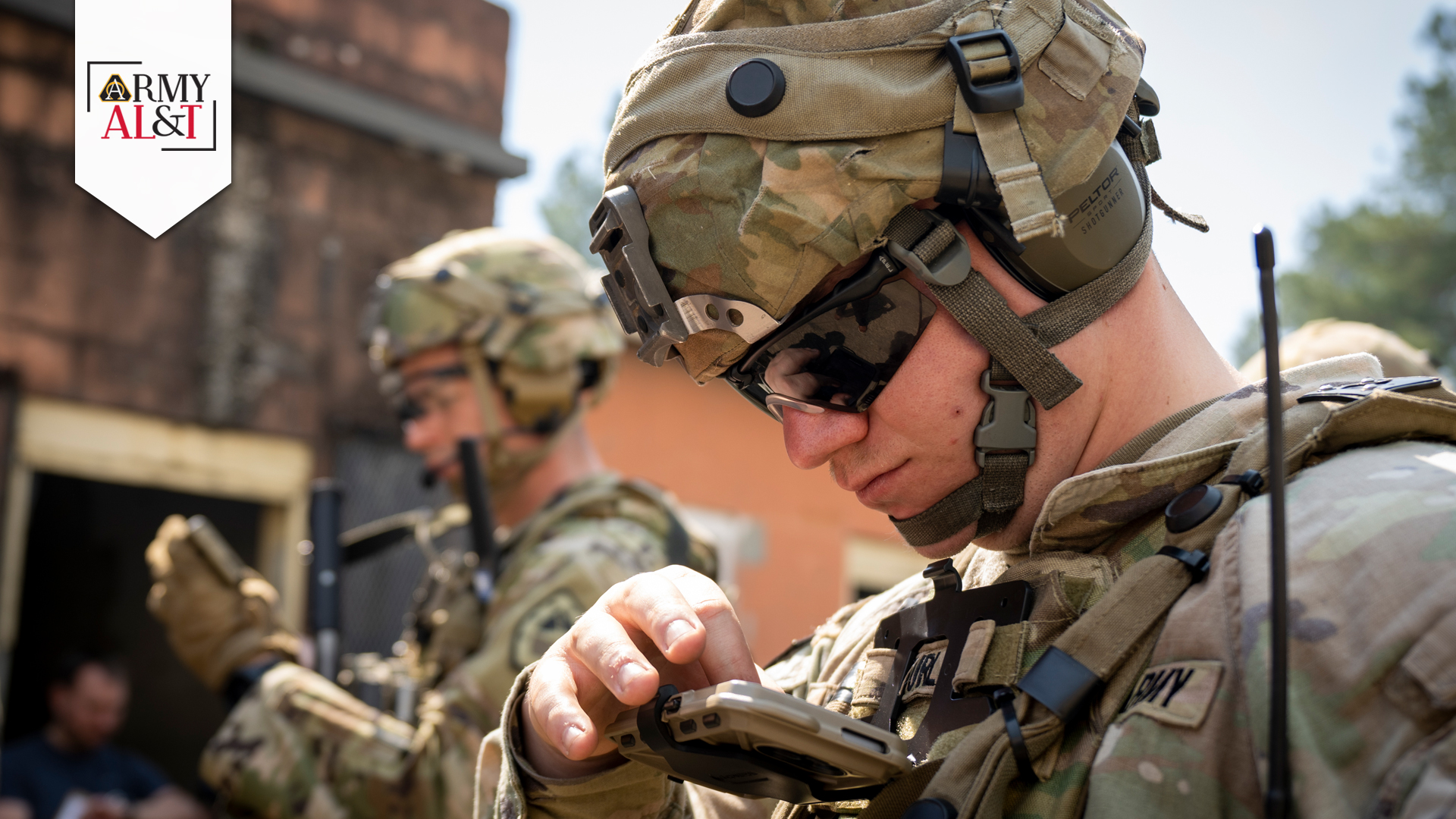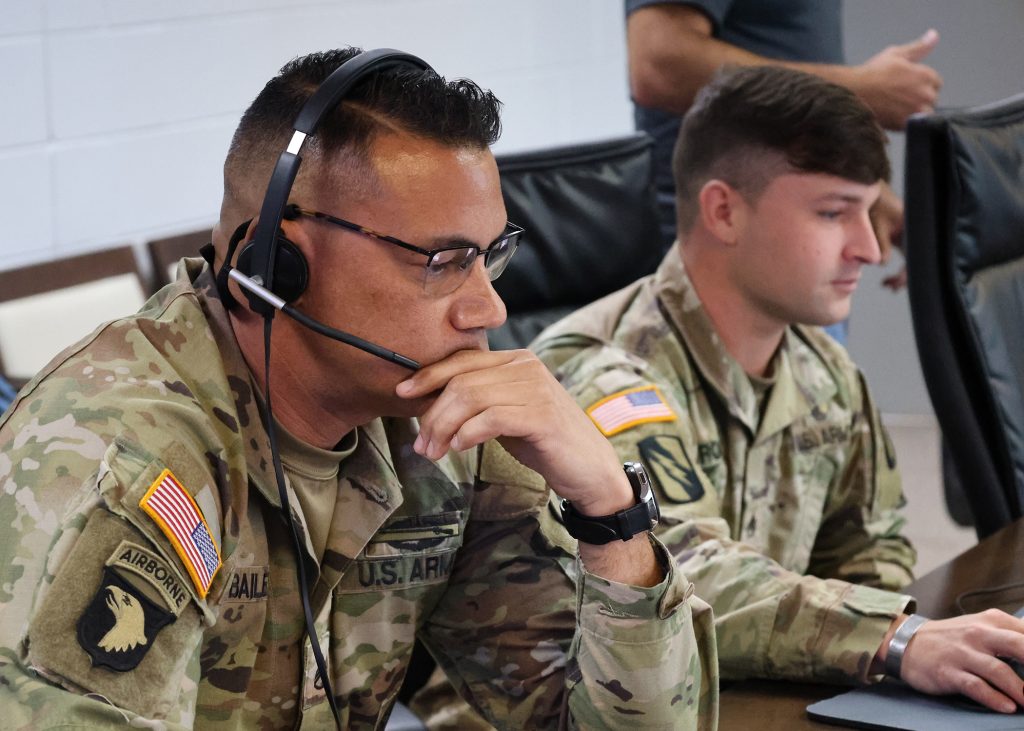
WORKING IN TANDEM: Soldiers demonstrate the practical application of the Soldier-Borne Sensor, Nett Warrior and artificial intelligence, working in tandem to enhance the situational awareness of the Soldier. Nett Warrior was one of the pathfinder programs selected to pilot a new software process using digital platform reference architecture to enhance digital transformation. (Photo by Jason Amadi, Program Executive Office Soldier)
Leaders push continuous integration/continuous deployment model and mindset to transform the Army’s cultural, process and technological foundations.
by Jennifer A. Swanson and Chad M. Claussen
Change isn’t just coming—it has arrived. And it’s the new operating paradigm for the U.S. Army. In “Quarterbacking Digital Transformation,” in the winter 2023 issue of Army AL&T, we examined how digital transformation forms the cultural, process and technological foundations that furnish our warfighters with rapid capabilities to counter emerging threats and harness emergent technology. This is the first article in an ongoing series highlighting and celebrating the changes being made, exploring the impacts and providing insight on how to leverage these changes.
Change is unsettling. It’s not comfortable. If we were honest, most of us would probably avoid change more often than embrace it. But the ability to change is the key to maintaining a competitive advantage on the battlefield. As technology evolves at an unprecedented pace, we are faced with both an opportunity and an obligation to adapt. We must enable rapid change. For the Army, that means not just policy changes but developing technical means to enable change, as well as cultivating a culture of continuous change.
The Army has committed to taking the steps necessary to be a more ready, lethal and modern force by 2028. Army leaders including Under Secretary of the Army Gabe Camarillo and Vice Chief of Staff of the Army Gen. Randy A. George are providing authority for driving the changes necessary to propel digital transformation across the Army. This is coupled with the arrival of new leaders in the Office of the Assistant Secretary of the Army for Acquisition, Logistics and Technology (ASA(ALT)), who prioritize and drive digital transformation for our programs.
These are pivotal events marking a watershed moment in the Army’s digital transformation odyssey. Rather than passively endorsing change, leaders are taking a top-down approach to drive a comprehensive digital transformation. At the core of the digital transformation strategy, and driven by Army leadership, is the adoption of the continuous integration/continuous deployment (CI/CD) model and mindset. CI/CD places the programs at the heart of the continuous software life cycle, where all software delivery—from new features to bug fixes and cyber patches—will now be owned, managed and executed by program executive offices (PEOs) and program managers.
To this end, the Office of the Assistant Secretary of the Army for Acquisition, Logistics and Technology issued new policy guidance in May that PEOs and program managers will no longer transition software to another organization for sustainment once it has been fielded. Instead, the software will remain with the PEOs and will receive continuous, iterative development and upgrades throughout its life cycle. This fundamental change symbolizes a shift toward a more dynamic, responsive and modern software practice.

DATA DRIVEN: Data is the strategic asset of the future. Investing in digital transformation and the modernization of the Army’s underlying network and computer infrastructure is essential to mission success. (Photo courtesy of U.S. Army Network Enterprise Technology Command)
WHAT IS A CI/CD MINDSET AND MODEL?
A cornerstone of this transformation is the adoption of a continuous integration/continuous deployment model and mindset. The essence of the CI/CD mindset is the understanding that software is never “done” but must constantly evolve to meet emerging needs. This is not just about deploying a technical pipeline of tools but is a holistic and complete process from idea to fielded operations across all aspects of the software life cycle. The continuous integration/continuous deployment model does include applying technical advances in the form of automated deployment pipelines that scan, test, evaluate, audit and deploy software at the precise moment needed to deliver value to the Soldier.
This shift embraces lean, modern practices, including transitioning from projects to products, enabling the Army to adopt new capabilities rapidly and adapt to the changing threat landscape. Traditionally, projects had a start and end date representing “code complete” with a transition to sustainment. In this new paradigm, where software must continually improve and change, software is treated as a product for the PEOs and programs to regularly advance.
Constant and consistent feedback from users is core to a continuous integration/continuous deployment mindset. The Army’s software must be Soldier-centric, reflecting the direct needs of the warfighter. This paradigm shift heralds the implementation of Agile methodologies, DevSecOps techniques, and the integration of digital engineering, particularly for simulations and emulations for testing.
FINDING OUR WAY
Adopting the continuous integration/continuous deployment mindset demonstrates the Army’s commitment to change and innovation, reaching beyond mere statements and permeating our practices. In line with CI/CD principles, the Army’s institutional blockers—the hurdles that can prevent progress from occurring—are being dismantled.
The Army conducted a Network Capability Portfolio Review (N-CPR) to help align digital requirements with associated resources and ultimately advance digital transformation. The N-CPR identified four “pathfinder” programs to pilot this new software process, including three warfighting systems and one business system. The Enterprise Business Systems-Convergence, Nett Warrior, Army Intelligence Data Platform and Cyber Situational Understanding programs were selected because of their broad set of institutional policy and process blockers. Based on the results of this effort, the Army is building a process to implement for all software programs by the start of the new fiscal year.
The pathfinder programs highlighted dramatic slowdowns occurring with attempting to field new capabilities in a system of systems. The digital platform reference architecture (DPRA) is being designed, which defines a new system of systems category enabling digital platforms and the capability products (i.e. applications) created and deployed with them to be decoupled. Applying the DPRA construct to software results in the ability to build, test, evaluate, assess and deploy software modules independently from one another. Capability products inherit the controls and process accreditation of the associated digital platform. The result is that only modules that have been changed need to be built, tested and deployed, creating streamlined and simplified interim authorization to test or authority to operate processes and rapid delivery of value to Soldiers. Individual modules can be deployed independent from an Army interoperability certification testing event.
The software material release (SMR) process is being streamlined, addressing the long and arduous program process. For example, we are reducing documentation required from dozens of documents down to roughly 13, which are statutory and already exist. Programs don’t need to generate new documents. The associated SMR training requirements are undergoing streamlining as well, to reflect software changes instead of the traditional hardware-centric view that can delay value delivery by a year.
We are also streamlining the SMR authority by empowering the PEOs of software programs to determine the safety, suitability and supportability of a software release. Who best to determine the impact of a change than the program and PEO? We are piloting giving PEOs the SMR authority and allowing them to tailor the process, which we expect to reduce the time to achieve a software materiel release from months or years to days or weeks. Based on the outcomes of the pilot, we intend to expand the policy to include all software programs by October.
Another significant reform is radically simplifying the Army Interoperability Certification (AIC) process and shifting testing to begin as early as possible in the iterative software development life cycle. In June, the Headquarters, Department of the Army G-6 signed a memo granting program managers (PMs) approval authority for AIC self-determination. This significant change has reduced approval time from months to days, allowing PMs to move forward with greater efficiency. Furthermore, AIC is moving toward a cloud-based certification capability. Using continuous integration/continuous deployment principles like defining infrastructure as code; being able to create, execute and tear down testing environments virtually; and automating test execution and results capture enables AIC testing repeatability, observability and auditability. The G-6 has agreed to these changes, and they are codified in executive order, DA EXORD 157-23, May 2023, to drive these important digital transformations.
This cultural shift reflects the Army’s commitment to fostering an environment that supports continuous software development, where teams have the autonomy to make decisions and drive innovation.

EXPANDING CAPABILITIES: Soldiers from the Mississippi Army National Guard assess the Training Simulation Software (TSS) and Training Management Tool (TMT). A continuous development process for the TSS and TMT will expand capabilities as new requirements are generated and technology evolves. (Photo courtesy of Program Executive Office Simulation, Training and Instrumentation)
POWERING DIGITAL TRANSFORMATION
The Office of the Deputy Assistant Secretary for the Army for Data, Engineering and Software (DASA(DES)) is driving digital transformation for ASA(ALT) by developing and delivering products and services to PEOs and programs. Our vision is of a data-centric Army, leveraging data for decision dominance and software-enabled change for competitive advantage. Our mission is to engineer pathways for digital transformation so that programs can deliver overmatch capabilities. Our strategy is to cultivate a passionate team of thought leaders and practitioners to drive digital transformation, providing an array of products and services spanning data science, digital engineering, modern software practices and cybersecurity.
DASA(DES) is creating architectures, road maps, guidelines, playbooks, policies and other products and services that enable digital transformation for programs. We are also gathering, packaging and providing training, job aids and Army-contextualized playbooks for an effective digital-first workforce.
The key is engagement. DASA(DES) is engaging with programs to provide direct support in solving immediate problems and removing barriers to digital transformation.
DASA(DES) has established a cadre of folks, called PEO liaisons, who are focused on facilitating digital transformation success. They provide a link between PEOs and DASA(DES) experts and align best-of-breed help to the programs. DASA(DES) has established a contract mechanism for fiscal year 2024 to help programs bring experts directly into the programs.
|
A CALL TO ACTION Digital transformation is not a destination; it’s a journey. It is an ongoing process of learning, adapting and innovating. Every member of the Army has a role to play in this journey. All PEOs and programs can benefit. Here’s how:
Your participation, your voice and your commitment are crucial to leveraging digital transformation to maintain our competitive edge and ensure the Army’s continued success. |
This is the beginning of a new era for the U.S. Army, an era defined by innovation, agility and a relentless commitment to progress. Together, we can leverage digital transformation to maintain our competitive edge and ensure the Army’s continued success. In doing so, we are not just shaping the future of the Army; we are securing the future of our nation.
For more information, email dasades@army.mil.
JENNIFER A. SWANSON is the deputy assistant secretary of the army for data, engineering and software (DASA(DES)). She is a Senior Executive Service member who leads implementation of modern software practices, including Agile software development and DevSecOps, data centricity and digital engineering across ASA(ALT). She earned an M.S. in software engineering from Monmouth University and a B.S. in industrial and systems engineering from the University of Florida. She holds the DAWIA Practitioner certification in both program management, and engineering and technical management.
CHAD M. CLAUSSEN is the director of the DASA(DES) Digital Transformation Directorate. He holds an M.S. in systems engineering management from the Naval Postgraduate School and a B.S. in information systems management from the University of Maryland. And holds the DAWIA Practitioner certification in engineering and technical management, and in program management.
CONTRIBUTORS: Tracy L. Bannon, chief architect and digital transformation expert, DASA(DES) Digital Transformation Directorate; Darren P. LeBlanc, senior technical adviser, DASA(DES) Digital Transformation Directorate







